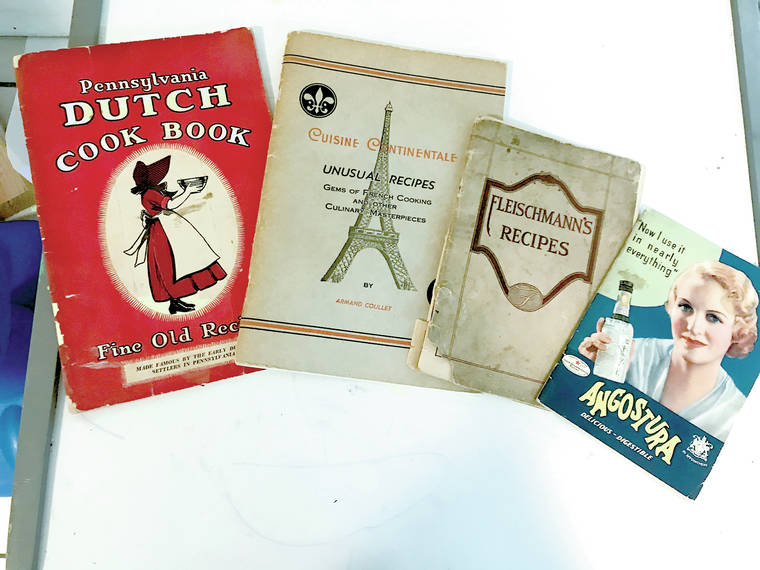Margaret Shiba, like many others, is working from home during this pandemic. She started to sort through old boxes of files, some with recipes her mother wrote by hand as a young bride. She also found little publications, printed between the 1930s and 1950s, “all sponsored by big food corporations for the benefit of housewives around the time of the war. Such period pieces!”
In 1920, The Fleischmann Co. put out a pamphlet of recipes using its yeast. Most recipes called for one cake of Fleischmann yeast to make bread, rolls, brioche and even cakes. Today, Fleischmann produces active dry and instant yeast. I love the company’s hints for baking with its yeast.
Little helpful hints
It will repay any young housekeeper to make a careful study of the foregoing information on the art of making good bread.
After the loaf is baked, remove from the pan and let it stand out of the draught until cold.
Sponges should not be permitted to get too light. They are ready when bubbles gather on the surface and break occasionally.
Use only the best of flour — it is the most economical.
Lard, butter, fat, oil, Crisco or other prepared shortening can be used.
A bread mixer is a very convenient kitchen utensil.
To freshen stale bread, dip it for a second in cold water or cold milk and then re-bake it in a rather cool oven. One of the best ways to heat rolls is to put them in a paper bag in the oven for a few minutes.
•••
Angostura printed a booklet with more recipes for its product than I have ever seen! The cover says, “Now I use it in nearly everything.”
I have been cooking and baking for a long time and have never added these bitters to anything, so it intrigued me to look at the recipes.
Dr. Johann Gottlieb Benjamin Siegert was born in 1796, practiced at one time in the town of Angostura on the River Orinoco. In 1824 he made an aromatic bitter but it was not until after his death that his two sons started to manufacture and distribute these bitters. Known as an appetite stimulus, it was added to every type of food, whether it is sweet, sour, soup or dessert.
Added to your morning orange juice or on your grapefruit, “this aromatic bitters not only adds but will tone up your appetite for every meal.”
No wonder it is not popular now. No one really wants to have an appetite and eat too much!
•••
In 1955, Armand Coullet of Jackson, Miss., wrote “Unusual Recipes, Gems of French Cuisine and Other Culinary Masterpieces.”
He writes, “The last recipe in this book is my favorite. It has been carefully guarded in my family for generations. Perhaps when this book is published, it will mark the beginning of an era for its author. I strongly suspect that all the ghosts, female gender, of my clan will meet in conclave and decree that I shall have no peace on this earth, and most certainly none thereafter if I remember my Tante Suzanne well … Be that as it may, this prize recipe is yours. Besides, I don’t believe in ghosts … .”
Canard aux Olives
(Duck with Olive Sauce)
Serves: 6
1/2 cup olive oil
1 large fat duck, disjointed
1 cup pitted olives
2 large ripe tomatoes, peeled and chopped
1 heaping tablespoon flour
10 small white onions
4 garlic cloves, crushed
2 cups white Sauterne wine
3 bay leaves
1 tablespoon chopped parsley
1 teaspoon thyme
Salt and pepper to taste
Wash disjointed duck and wipe dry, then roll in flour. (The amount of flour is not listed)
In a heavy pan, heat a half cup of olive oil and sear duck over medium fire, turning pieces frequently. When browned, add onions, whole, and brown, then add tomatoes.
When tomatoes are well integrated, add a heaping tablespoon of flour, stirring constantly to avoid lumping. Add 2 cups white wine, 3 cups hot water, parsley, thyme, garlic, bay leaves, olives, salt and pepper to taste.
Set over low fire until well done.
•••
“Pennsylvania Dutch Cookbook of Fine Old Recipes” was published in 1936. In the early 18th century, German immigrants settled in Eastern Pennsylvania and became known as “Dutch” instead of “Deutsch.”
I wonder if the ovens in 1936 did not have temperature adjustments, as this recipe for a Dutch pancake doesn’t state the temperature that the oven should be set at.
Dutch Pancake
3 eggs, well beaten
1/2 cup flour
1/2 teaspoon salt
1/2 cup milk
Beat the eggs thoroughly and add the flour and salt. Continue to beat and add the milk while beating. Pout into a well-buttered pan and bake for 25 minutes. Serve with powdered sugar and lemon juice.
•••
Turkey is stuffed with chestnuts as in this recipe:
Chestnut Stuffing for Poultry
1 quart chestnuts
1 pint bread crumbs
1/4 cup shortening (butter, chicken fat or lard)
1 teaspoon salt
1 egg, well beaten
1/4 cup chopped celery
2 teaspoons poultry seasoning
Make a gash in each chestnut, place in an iron skillet with 1 tablespoon butter and shake over hot flame for a few minutes. Place in the oven for 10 minutes. Then remove the shell and skins. Cover the blanched chestnuts with boiling salt water and cook until tender. Strain and put through a ricer. Add the rest of the ingredients and mix well.
Email Audrey Wilson at audreywilson808@gmail.com.


